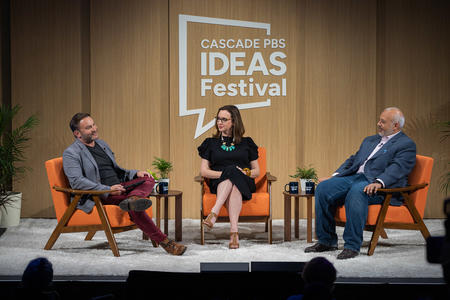“Cities are made, not by conditions, but by men.” —Ben Ehrlichman, Century 21 trustee
Today, we complain about “Seattle process,” the dithering, second guessing, making and remaking of every major decision, from the Alaskan Way Viaduct replacement and downtown tunnel to the 520 bridge expansion, to the Green Line monorail system. Was there ever a time when we got it right the first time?
I’m writing the official 50th-anniversary history of the Space Needle, and the archives offer a window on the Seattle process of yore. The drive to create the Seattle world’s fair, for which the Needle was built, began in the mid-1950s, and it has never been replicated. Powerful men met for years over 7 a.m. breakfasts at the Olympic Hotel and plotted an international event aimed at “putting Seattle on the map” as a modern, “Space Age” metropolis.
The project involved many steps, as fairs do, and the better part of a decade to make it a reality. There were public votes, public-private partnerships, lawsuits, twisted arms, old-fashioned salesmanship and a team of dedicated civic dynamos, nearly all men who knew the ins and outs of the Rainier Club, and were composed of young, ambitious execs and the city’s older, blue-blooded bedrock: Old money meets Mad Men.
Once Century 21 was rolling down the track, once the city’s power structure had made a collective decision to make the fair happen, things took shape with astonishing speed. The Space Needle is a great example. The idea for it, spawned by fair organizer and hotel exec Edward “Eddie” Carlson, came relatively late. But a search of Seattle newspaper card files at the University of Washington’s Special Collections offers an amazing glimpse of Seattle’s movers and shakers operating at time-lapse speed.
Check out this sequence of headlines from The Seattle Times:
September 12, 1960: “500-foot Tower Proposed for Fair”
November 1, 1960: “Legal Obstacles May Block ‘Needle’ Bonds”
December 4, 1960: “Private Funds for Space Needle”
December 15, 1960: “Sales Agreement OK’s Space Needle”
March 12, 1961: “4 Businessmen Will Finance Space Needle”
March 23, 1961 “Zoning Variance Sought for Space Needle”
April 5, 1961: “Permit for Needle Recommended”
April 13, 1961: “Space Needle Beams Arrive”
From the time the plan for the Needle was announced to the public, it took just seven months to get to groundbreaking — an extraordinary pace in modern terms. A typical high-rise condo today can easily take two to three years to cover the same ground.
Was the Needle a slam dunk? No. The fair organizers were counting on public funding, but the city turned them down at the last minute, fearing the tower would become a post-fair “white elephant.” So, a scramble was on to find deep-pocketed private investors to risk millions on the project. A piece of land to build on had to be found, purchased and zoned. In some respects, the Needle’s expedited process had the hallmarks typical of Seattle: Questions were raised about its public benefit, location, viability. But the process
was telescoped. One reason for speed: a deadline. The fair opening, slated for April 21, 1962, was one organizers could not miss without international embarrassment.
Why are we so sluggish now? There were no environmental impact statements back then, and the city was largely controlled by an old-boy network that didn’t always worry about neighborhood impacts. Approximately 200 homes were bulldozed to make room for the fair. Public input was limited; there were no endless hearings. The major media were behind the fair effort.
And the fair itself would not have happened without bipartisan support in Olympia or a special assist from the U.S. Senate power duo of Warren G. Magnuson and Henry M. “Scoop” Jackson, so adept at getting federal funding for Seattle projects.
The ’62 fair and the raising of the Needle were not typical of Seattle process; rather it transcended the usual by rolling forward with an exciting and timely vision, a big gamble and super salesmanship. Such mobilizations are by definition rare, but when they work, they leave behind important legacies, like this one: a reminder of the power of cooperation and of a city galvanized, with the eyes of the world watching.
This story first appeared in the September issue of Seattle Magazine, where the author is a regular columnist.



